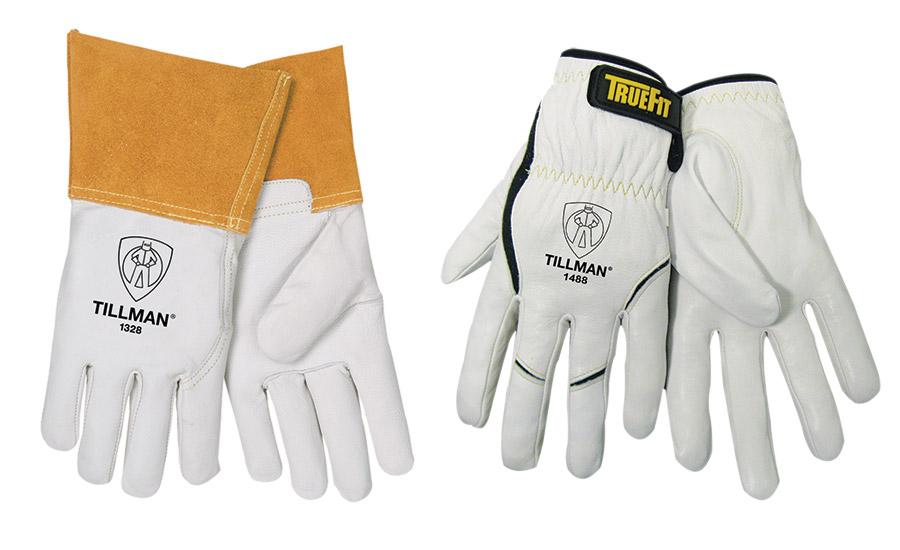How to select TIG gloves
October 2019 - TIG welders are passionate and outspoken about their gloves—and the features they need to do their jobs correctly. Because TIG welders often encounter a broad spectrum of fine detail, they not only require protection from both heat and UV rays but also agility and durability. When it comes to TIG gloves, there is a delicate balance between the level of touch and sensitivity needed and protection from heat buildup. TIG gloves with a softer leather provide the right touch, sensitivity and dexterity required for controlling the torch and filler rod to execute that perfect row of dimes.
With the balance of managing the torch and adding the filler material, the TIG welder relies on a delicate touch to glide the filler rod on the glove, so TIG gloves generally are thinner and conform more closely to the hand. Generally, top-grain kidskin, goatskin or a reverse deerskin offer the characteristics needed to maximize the welder’s sense of feel and dexterity.
Here are some factors to consider when looking for the right TIG glove.
Leather choices
Different leathers offer a range of sensitivity. Kidskin, goatskin and reverse deerskin are soft and supple with superior sensitivity. Kidskin and goatskin, among nature’s strongest leathers, have very high tensile strength and strength-to-weight ratio, with goatskin offering a bit higher ratio because it is slightly thicker than kidskin. Goatskin offers exceptional abrasion-resistant properties and is a tougher and more durable leather than its suppleness leads you to think. Kidskin is a bit thinner than goatskin, allowing for a slightly better touch and dexterity. For these reasons, a majority of TIG gloves are made from goatskin and kidskin.
Reverse deerskin is by far the thinnest leather and delivers a tremendous sense of touch but is not as suited to handle all materials because the leather is so thin. Top-grain pigskin is a bit thicker than deerskin or kidskin and is still a useful and popular TIG glove because it also offers good sensitivity, in addition to being naturally resistant to oils and water.

Insulation and radiant heat
Because TIG welders require superb feel and dexterity, TIG gloves are not insulated with a fleece or foam. If a welder needs some level of insulation, a glove lined with a DuPont Kevlar or a para-aramid material provides some heat resistance without bulk. Or, a thicker leather like pigskin can can provide some level of natural insulation.
If workers perform a large amount of production-type TIG welding for many hours and want a glove with some insulation to reduce the buildup of radiant heat, they can consider a thinner, unlined MIG glove as an option.
Although TIG welding is a more precise process and does not create the sparks and spatter of MIG welding, welders still need some protection above their forearm or wrists. Many TIG gloves are offered in both 2-in. and 4-in. cuffs. There is no right or wrong answer regarding cuff length—it’s a personal preference.
Cut protection and UV exposure
More welders are using TIG gloves like a multi-use glove, such as when handling materials. Cut resistance is delivered with either a DuPont Kevlar or para-aramid lining and the gloves should feature the ANSI cut-resistant shield to indicate the cut rating. These-cut resistant linings also provide some level of heat protection.
UV exposure is often overlooked, but is a topic that should be taken seriously. Essentially, UV radiation created from TIG welding, as well as the UV rays reflected from metal surfaces, walls and ceilings, can burn unprotected skin, just like UV rays from sunlight. UV protection for the hands is often overlooked but is just as important as it is for the arms, throat and any other body part.
Bottom line, wear gloves, a shirt or sleeves to protect you from these harmful UV rays and keep you from getting a “welder’s tan.” Remember, long-term exposure to UV radiation can cause skin cancer.
When it comes to finding the right TIG glove, the choice is completely up to the welder. Sense of touch, heat protection, cut protection and cuff length are just a few factors to think about.
John Tillman Co.
Compton, California
800/255-5480

